Rega Planar-3 Table, with Rega RB-301 Arm, Dynavector 10X5 Cartridge, Dust & Rec weight
Listed · 205 Views
This listing has ended.
Listings Similar to Rega
Time Left: Listing Sold
This listing has ended.
| Condition | |
| Payment methods | |
| Ships from | Los Angeles, CA, 90077 |
| Ships to | United States and Canada |
| Package dimensions | unspecified |
| Shipping carrier | UPS |
| Shipping cost | |
| Research Pricing |
FLASH SALE:
Beautiful Rega P-3-24 turntable complete with Dynavector 10x5 $650 cartridge, Dust Cover & Record Weight
Great Table, Arm & Cartridge in a very nice package for analog playback especially at this price point / highly recommended...
Another option is: selling it with a Ortofon MM cartridge new 2M Red and if used instead combination $795.
Or: Call for other Cartridge options we are a authorized dealer for most cartridges and here to help you to make better sound.
Please note: It comes with Dust Cover, extra belt & Record weight (it is best to call for cartridge options)...
Rega is well known for producing some of the most popular turntables on the market. This turntable is in excellent condition and well cared for. It is partnered up with a Rega RB 301 tonearm and a Dynavector 10x5 Moving coil cartridge and a separate Rega Power supply and an extra drive belt. Get in on this deal while you still can.
Rega P3-24 Turntable
Al Griffin | May 31, 2008
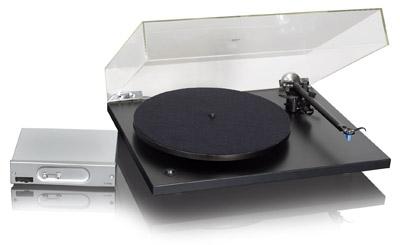
| The Short Form |
| $1,470 (as tested) / REGA.CO.UK / 972-234-0182 |
| Snapshot |
| A smart step-up turntable for vinyl addicts looking to take things to a higher level of sound quality |
| Plus |
| • Great performance for the price • Solid build quality • Quick, easy setup • Heavy-duty phono cable |
| Minus |
| • A turntable this good can reveal lousy recordings and bad LP condition! |
| Key Features |
| • 24-volt motor with anti-vibration circuit • Optional TTPSU power-supply unit switches between 33 and 45 rpm • Can be optionally outfitted with Rega Elys 2 phono cartridge • Includes cartridge-alignment protractor |
Working at a record store in the mid-1980s after graduating from high school, I was regularly baffled by the people who would trade in crates of vinyl LPs - collections that sometimes included pristine, rare stuff - for enough credit to cruise out with a mere handful of expensive CDs. (I seem to remember some of them smirking as they left, al- though I might be inventing that detail.) To these folks, it was a sweet deal: They unburdened themselves of an obsolete format and, at the same time, got a foot in the door of the new Compact Disc revolution. To me and my co-workers, however, they were just Yuppies (a slight that carried some weight back then) who were committing a crime against music.
Fast-forward to the present: People are buying a lot fewer CDs, while the vinyl market is not only chugging along nicely but expanding. Any artists with an ounce of self-respect make sure that their new albums get released on both CD and vinyl, and there's a thriving reissue industry for rock, jazz, and classical LPs. Over the past decade, I've been content to listen to records old and new on my first "real" turntable, an entry-level Pro-Ject 1.2. But as my fascination with vinyl has evolved, I've often wondered what could be gained by stepping up to a mid-level turntable - something like Rega's new P3-24.
The British-made P3-24 takes over from the P3 2000, a now-discontinued step-up model in Rega's well-established line of turntables. A number of elements have been retained, including the 15mm-thick glass platter, the main bearing, and the drive belt. But the P3-24 is an otherwise fresh design, incorporating a low-vibration 24-volt motor (previously found only in the higher-end P5), a Medite plinth with resin laminate overlay, and Rega's new RB301 tonearm, which improves on the tried-and-true RB300 by adding a three-point mounting system for extra rigidity - as well as the same heavy-duty phono cable with gold-plated connectors found in the RB700.
For this review, Rega sent me a P3-24 outfitted with the company's Elys 2 moving-magnet phono cartridge (a $200 option) and TTPSU power supply ($375, shown to the left of the turntable in the photo). The latter is a nifty external box that feeds the motor (located under the plinth) with a line-conditioned, low-distortion 24-volt AC input; it also triggers the motor's anti-vibration circuit. But the TTPSU's most tangible benefit is a front-panel switch to conveniently toggle between 33 and 45 rpm. Otherwise, changing playback speed on the P3-24 requires lifting its platter and switching the motor pulley that the drive belt is connected to - the same rather clumsy procedure as with my Pro-Ject 1.2. Needless to say, I find the TTPSU to be a worthy upgrade.
Right off, I was struck by the P3-24's appearance. While not fancy, this turntable manages to look at once solid and sleek. It's also relatively light - Rega's apparent philosophy being that excess mass only serves to store up excess energy, which can ultimately have a degrading effect on sound quality. The glass platter rests on a slim slab of a plinth, and the whole thing balances on a trio of rubber feet that serve to distribute the 'table's mass evenly, as well as couple it firmly to whatever surface it's placed on. Rega's impressively solid acrylic dust cover is also completely nonresonant, and it flips up with fluid, graceful motion when you lift it to move the tonearm or change record sides. (You remember record sides.)
NEXT: Page 2 »
Rega P3-24 Turntable Page 2
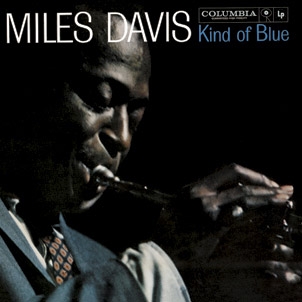
Rega designed the P3-24 for easy setup, so you don't need to buy an extensive kit of turntable adjustment tools just to start spinning. After laying the platter on the plinth, I slid the tonearm counterweight onto its back section and used my inexpensive Shure SFG-2 stylus-force gauge to verify that the cartridge was set at the recommended 1.75-gram tracking weight. A special protractor comes with the 'table for aligning cartridges other than Rega's Elys 2 model. Using this tool, it was a snap to confirm the perfect factory alignment of the cartridge's headshell.
Connecting the TTPSU's cable to a socket at the back of the plinth, I turned on the power supply and looked for a red LED to let me know the Rega was running at 33 rpm - check. My final step was to balance the turntable by adjusting the spikes underneath my equipment rack's top shelf with a level sitting on the platter's surface. Finding the bubble perfectly centered, I was good to go.
PERFORMANCE
I started my evaluation with Wilco's Sky Blue Sky, an LP that I'd recently logged many hours listening to. Immediately, I could hear differences with the P3-24, particularly in the highs, which sounded distinctly clearer than they did with my regular turntable. For instance, Jeff Tweedy's vocals on "You Are My Face" came across as dry and gritty on the Rega - a quality that, I have to say, pushed his voice out uncomfortably toward the front of the mix. Other treble details, such as the cleanly recorded ride cymbal and even Nels Cline's skronking guitar during the song's explosive midsection, were even and balanced by comparison. The Rega P3-24 just seemed to convey the true sound of this recording better than my Pro-Ject 1.2 did. Indeed, the latter turntable was much more sonically forgiving. (Probably a good thing given the condition of some of my older records.)
The Rega's ability to reveal microscopic sonic details set me on a mad stint of comparative listening - as well as some careful record cleaning. Spinning "Cello Song" from Nick Drake's Five Leaves Left, I was impressed by the smooth quality of the vocals (Drake is the anti-Tweedy), as well as the crisp delineation of the acoustic guitar and bass, hand percussion, and of course, cello. The Rega 'table's ability to convey a solid-sounding low end was also apparent on this track; until then, I wasn't aware that the song contained this much bass.
Another thing that struck me was the sense of definition, focus, and space that the P3-24 brought to specific instruments and voices. It was something that I experienced vividly when listening to Classic Records' reissue of Miles Davis's Kind of Blue. On the track "Blue in Green," the location of the musicians was perfectly clear: Miles dead center, pianist Bill Evans at left, and Jimmy Cobb's wispy, subtle scraping of brushes across a snare drum emanating from the right of the soundstage. Listening to this track's first 2 minutes practically put me in a trance, but then a lone ride-cymbal ping, followed by John Coltrane stepping forward to solo, pulled me straight back into 3-D reality. Hearing the Rega's realistic and coherent presentation of this recording was nothing short of a revelation.
BOTTOM LINE
Starting at the base price of $895, Rega's P3-24 turntable combined with the company's RB301 tonearm and Elys 2 cartridge ($200 extra) represents a solid and affordable step up for a casual vinyl collector looking to enter the high-fidelity Big Leagues. I approached the P3-24 with open ears, hoping to hear a noticeable improvement in the sound of my records. Not only did the turntable deliver on that promise, it also opened my eyes to the sonic potential (and in some cases, weakness) of my record collection. When you add the company's TTPSU external power supply, the package becomes all the more appealing. Those smirking, CD-adopting yupsters may be gone, but vinyl sure isn't - and when played on a turntable like the P3-24, it can sound better than ever.
High Output with Aluminium Cantilever
Discontinued model
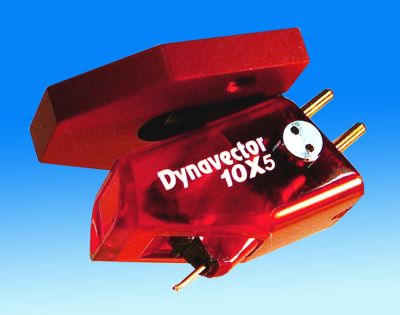
Description
The Dynavector 10X series High Output Moving Coil cartridge debuted in 1978 winning the prestigious Design and Engineering Award at the Chicago CES in both 1978 and 1981. The 10X series cartridges are also widely accepted at the benchmark in High Output moving coil cartridge at this price point and beyond.
With the introduction of the new 10X5 High Output moving coil there is no doubt Dynavector will retain this enviable position and again set the standard for high output moving coil cartridges.
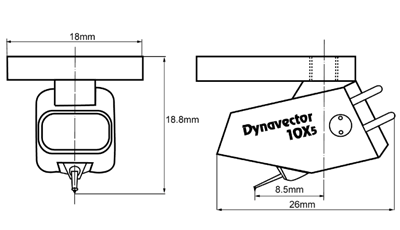
Improvements
The 10X5 now features Dynavector's unique magnetic flux damping and softened magnetism (patent) along with powerful Neodymium magnet that combine to eliminate any hardness or irritating edginess that commonly occurs in many moving coil cartridges.
Dynavector are also renowned for the capability of winding the finest coil assemblies. This has enabled them to minutely increase the coil wire diameter of the 10X5 to achieve a reduction of impedance to 150 ohms whilst retaining a healthy 2.5mV output. This also ensures both a rugged and reliable circuitry.
The 10X5 also features a newly designed Aluminium head block with M2.5 thread to provide a rigid platform for the cartridge motor and secure fixing to the tonearm.
Specifications
| Type | High output moving coil cartridge with flux damper and softened magnetism |
| Output Voltage | 2.5mV (at 1KHz, 5cm/sec.) |
| Channel Separation | 25 dB (at 1KHz) |
| Channel balance | 1.0 dB (at 1KHz) |
| Frequency response | 20 - 20,000Hz (± 1dB) |
| Compliance | 12 mm/dyn |
| Tracking force | 1.8 - 2.2 g |
| Impedance | 150 ohms |
| Recommended load impedance | > 1K ohms |
| Cantilever | 6mm length aluminium pipe |
| Stylus tip | Elliptical |
| Weight | 7.3 g |
PHONO CARTRIDGE REVIEWS
Dynavector DV10x5 MC phono cartridge Page 2
Given the above, you should know what it takes to use the DV10x5 in that setting. In particular, because the new Dyna is taller than the average phono cartridge—almost 19mm from the surface of the record it's sitting on to the top of its mounting platform (15mm is about average)—there's no escaping the fact that the owner of a Planar 3 absolutely must reposition the tonearm in order to raise it slightly, relative to the platter, to bring the stylus angle within spitting distance of the ideal.
Luckily, this is easy to do: Remove the arm, place one or two standard Rega shims (available from your Rega dealer for $12 each) under its base, then replace and retighten the arm. I had fine results using a single shim under the arm base, in combination with a thinner-than-standard Linn felt mat. Before that, with the armtube too low, leading-edge transients were dull, musical timing suffered, stereo imaging was vague and lackluster. My theory is that, whether or not imaging is crucial to your enjoyment of recorded music, it's never a good idea to throw away something you've already bought and paid for.
All that said, it was interesting to note that the Dynavector DV10x5 is a physically perfect match for the Naim Aro tonearm, with its lack of provisions for adjusting overhang and tracking angle. From the cross centered at the Dyna's mounting holes to its stylus tip, the DV10x5 measures 9.4mm, which is exactly what a properly installed Aro requires for "automatically" correct alignment. Suddenly, the idea of a $360 cartridge on a $2500 tonearm doesn't seem quite so silly.
Electrically, the DV10x5 looks for any reasonable load over 1000 ohms—meaning that the 47k ohm load I had in mind, and that the cartridge would surely see in the vast majority of installations, was okay. For the record, the Dyna's own coil impedance is 150 ohms, which would indicate good (ie, efficient, non-bandwidth-compromised) transfer of power at highish preamp input impedances.
And the 2.5mV output? The MM boards on my vintage Naim preamp dealt with it handily, with most of my listening done with the volume knob at about 1 o'clock—this with a Naim 110 amplifier, Quad ESL-989s, and a listener who prefers moderate to loud levels.
One more setup observation: I had the best results tracking the Dynavector at 2.2gm, noted conditionally: ie, cartridge aligned carefully in accordance with a Rega-specific Wallytractor (footnote 1), broken in and played during mid-summer months at an elevation of approximately 1000' above sea level by a left-leaning reviewer. At lower forces than that, tracking ability suffered, especially audible on Wagnerian voices; at forces even slightly higher, the music sounded coarse, sluggish, and uninteresting.
Sing!
But dialed-in and broken-in, Dynavector's new cheapie was like a new Mini Cooper, or a John Deere L100 tractor, or almost every disc I've heard on the Naxos label: ridiculously good for the money.
On Cisco Records' superb reissue of the Milstein-Steinberg-Pittsburgh recording of the Dvork and Glazunov violin concertos (Capitol SP8382), the DV10x5 gave a clear, colorful, and reasonably well-scaled picture of the orchestra, with a large and very well-textured solo violin in front. Pitches were fine, there was faultless sense of musical flow—each of the many times I enjoyed this record with the Dyna, the experience was one of excitement rather than fatigue—and the PSO's famous ability to stop and turn on a dime was fairly portrayed. It was a "stop there" experience in almost every way: Yes, I suppose there are cartridges that make this record sound even more transparent, and maybe even more dramatic, but who can conceive of such a thing when listening to this? And for just $360?!
The DV10x5 was not a cartridge that required a steady diet of audiophile slop in order to earn its keep. There's more great tone than you'd expect in a lot of older Deutsche Grammophon LPs, for instance—the world-beating Beethoven Fifth by Carlos Kleiber (2530 516, available on reissue from Speakers Corner) being just one. The Dynavector found it, delivering rich, woody string sounds without compromising pitch accuracy or pacing.
More evidence of the Dyna's fine rhythmic qualities could be heard on Crosby, Stills & Nash, especially on Stephen Stills' "You Don't Have to Cry." (I have a standard Atlantic SD-8229 pressing and the Classic Records reissue, both good-sounding in their own ways, the latter boasting much quieter surfaces.) The Dyna was sufficiently free from lag, so the song moved forward easily (it doesn't always). The cartridge gave a clear enough temporal picture that it was easy to tell that the electric bass had been overdubbed after the bulk of the performance had already been recorded: The former keeps time; the guitars and voices that constitute the latter don't always.
I found it impossible to enjoy those acoustic guitars without wanting an even stronger dose of same—as on Rice & Blake, the first album recorded by bluegrass and old-time masters Tony Rice and Norman Blake (Rounder 0233). Tony's capoed guitar on the traditional "Little Beggarman" had just the right timbral fingerprint and perfect sonic texture; notes tumbled out with clear pitch and rhythmic shadings, and an almost startlingly realistic sense of the real human force of the picking behind them. That set the stage nicely for the next tune, "Shipyard Apprentice," on which Tony plays without capo—his instrument's consequently deeper bass showed off the DV10x5's rich, colorful, tight bottom end.
The fine Beethoven Egmont by George Szell and the Vienna Philharmonic (Decca SXL 6465, also on a Speakers Corner reissue and a fairly easy-to-find London LP) showed off the Dynavector's good poise under fire: It got louder without showing too much strain—the high-priced spread remains almost inevitably better, of course—and during the louder passages the sound slapped realistically off the walls, with what I consider the right amount of die-away. Imaging was fine, too—even the flutes, even under the great duress of the final bars of both the Egmont and the Siegessymphonie.
PHONO CARTRIDGE REVIEWS
Dynavector DV10x5 MC phono cartridge Page 3
And most of all, it made Guided by Voices' Bee Thousand (Scat 35) sound messy and fun, which it is. What else is there?
The only other thing that comes to mind is the issue of vinyl noise, be it steady-state (groove grunge) or not (tics and pops), said performance being a function of stylus profile, stylus condition (the extent to which it's been properly polished), and the cantilever's ability to shrug off rather than store resonant energy. Here the DV10x5 gets a solid "Good" rating: It was better than all the MM cartridges I know and even some of the MCs, pricier ones included, although severe record damage could still trip it up. (Lyra's cartridges remain the best I know in this regard, for whatever combination of reasons.)
It's finished
Here's a list of things I liked about the Dynavector DV10x5:
• Top of the list, I liked the way it played music, which it did with pitch and timing accuracy and a fine, organic sense of flow.
• I liked the way the Dyna did textures. As I said above, the first Dyna I heard did textures like that when I didn't even know my LPs contained such a thing. Feel free to think me merely nostalgic, but it's not only that: This cartridge had the same kind of magic.
• I liked the way the Dyna imaged. It had depth, but not so much that my attention went there instead of to the notes and beats. Ditto image placement and solidity.
• I liked the fact that the Dyna had color without being colored.
• I liked that it didn't sound tiny. It wasn't as big as could be, but it wasn't puny, either.
• God help me, but I love the way it looks. I'm glad the DV10x5 looks pretty much the same as the old DV10, which itself was somewhat anachronistic, being so big and all. The big, translucent red housing is beyond cool, I think, and while Dynavector makes better cartridges, none is prettier than the DV10x5.
• I liked the fact that the DV10x5 is a high-output MC cartridge that didn't sound hard. Sorry to paint with so broad a brush, but the sounds of most such products—even expensive examples of the breed—have struck me as having an edgy or hard quality. It has never been explained to my satisfaction why most high-output cartridges sound worse in this regard than their low-output brethren, all other things being equal; and while it's not difficult to imagine how a more massive coil former or even more massive coils can present certain performance shortfalls, I have a hard time accepting that as the culprit. Whatever: The important thing is that Dynavector's cheap, high-output cartridges have never sounded harsh to my ears, and the DV10x5 carried on that fine tradition.
• I love the price. While Dynavector makes better cartridges, none is a better value than the DV10x5.
Here's a list of things I didn't like:
• When Dynavector designed their new mounting plate, they could have threaded the holes. They didn't.
Finishing it
What does a megabuck cartridge give you that the Dynavector DV10x5 doesn't? Those Lyras and most van den Huls are quieter in the groove, and while the DV10x5 was no slouch in that respect, it can be bettered. Some more expensive phono cartridges can also sound more open and transparent than this one, and they and others will deliver a little more imaging precision and depth, if that's your bag, and a more realistic sense of scale.
But if you want something that does everything better—sound and music—you have to buy something like a Linn Akiva or a Tubaphon TU-2 ($2950 and $2150, respectively). And from there up, improvements cost crazy money—like the $3950 Miyabi 47. Go ahead: It's your kids' education, so what do I care?
The first entry-level Dyna I ever heard was the first DV10x cartridge—which I bought, sound unheard, on a dealer's recommendation back in 1979. It was the first MC cartridge I'd ever owned, and I was knocked out. I remember especially listening to Leonard Cohen's New Skin for the Old Ceremony and being astounded at how much rich detail and texture that Dynavector pulled out of the grooves: Voices and stringed instruments sounded like themselves, the latter sounding especially...well, stringy—just as they do in real life. I remember playing "Who By Fire" and "The Bells" over and over, so mesmerized was I by the beauty of both the sound and the music-making.
The Dynavector DV10x5 more than lives up to my memory of its predecessor. This colorful, well-balanced, chunky-sounding cartridge played music extremely well, with a bonus of very fine stereo imaging. In other words, it's a great all-arounder. More money can buy more drama, impact, scale, and transparency, just as more money can buy a slightly faster car or torquier tractor. But the Dynavector DV10x5 should give you most of what I think you need at a bargain price. Wildly, highly recommended.
-----------------------------------------------------------------------------------------
* * * We are always interested in purchasing quality Audio and Video items, LP collections and quality trades are welcomed. * * *
Please feel free to view our other used items for sale on Audiogon or come to our website to view our new products and see the exciting new lines we have to offer you like Bowers & Wilkins, Bryston, Aqua Acoustics, Rel Acoustics, Synergistic Research, Roon Labs, Pro-ject, Van Den Hul, Marantz and many others.
We are proud to be the dealers representing the new B&W 801 D4 Diamonds.
It is best to call David and visit: www.weinhartdesign.com with questions or come to our Los Angeles Showroom 310-472-8880 or on my cell after hours and weekends 310-927-2260 any time from 10AM - 7PM PST.
Weinhart Design has lots of other items new and used and if you’re in Los Angeles or visiting please accept my invitation to experience our World Class Audio Showroom and please visit our web site @ www.weinhartdesign.co
We accept payments by Bank Wire Transfers without fees and is the only form of payment on all sales out of the U.S. and Canada.
We prefer this method of payment and also makes shipping to addresses other than billing agreeable. VISA, MC and Papal are gladly accepted within the U.S. and Canada as long as the charge is approved and shipping to the billing address is to the one on record and plus 3% to cover card service costs.
Please call me directly in my world class showroom in Los Angeles weekdays @ 310-472-8880 or any reasonable time on my cell including weekends @ 310-927-2260 and I can answer your questions and help you with all of your new and pre owned needs.
* * * We are always interested in purchasing quality Audio and Video items, LP collections and quality trades are welcomed. * * *
Please feel free to view our other used items for sale on Audiogon or come to our website to view our new products and see the exciting new lines we have to offer you like Bowers & Wilkins, Bryston, Aqua Acoustics, Rel Acoustics, Synergistic Research, Roon Labs, Pro-ject, Van Den Hul, Marantz and many others.
We are proud to be the dealers representing the new Diamond B&W Reference Speakers.
It is best to call David and visit: www.weinhartdesign.com with questions or come to our Los Angeles Showroom 310-472-8880 or on my cell after hours and weekends 310-927-2260 any time from 10AM - 7PM PST.
Weinhart Design has lots of other items new and used and if you’re in Los Angeles or visiting please accept my invitation to experience our World Class Audio Showroom and please visit our web site @ www.weinhartdesign.co
We accept payments by Bank Wire Transfers without fees and is the only form of payment on all sales out of the U.S. and Canada.
We prefer this method of payment and also makes shipping to addresses other than billing agreeable. VISA, MC and Papal are gladly accepted within the U.S. and Canada as long as the charge is approved and shipping to the billing address is to the one on record and plus 3% to cover card service costs.
Please call me directly in my world class showroom in Los Angeles weekdays @ 310-472-8880 or any reasonable time on my cell including weekends @ 310-927-2260 and I can answer your questions and help you with all of your new and pre owned needs.
Changing the Way You Listen,
The Audio and Video Experts...
David Weinhart and the Weinhart Design Audio team
President & CEO [email protected]
Visit our Weinhart Design Audiogon The AV Experts STORE:
2337 Roscomare Road, Studio #1
Los Angeles, California 90077
(Showroom) 310-472-8880
(Cell) 310-927-2260 10AM-7PM West coast time
www.weinhartdesign.com
🎶 🎵 ...
No questions have been asked about this item.
Ask the seller a public question
You must log in to ask a question.
Return Policy
Return Window
Returns are not accepted on this item.




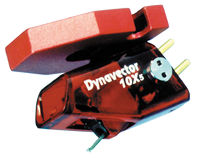 It's reasonable to expect five years or more out of a good cartridge, especially if you keep it and your records clean and avoid using it when you're drunk or high. On the other hand, it's not unreasonable for the cartridge industry, as it were, to ask you for more money every five years or so, because they work hard to make you happy.
It's reasonable to expect five years or more out of a good cartridge, especially if you keep it and your records clean and avoid using it when you're drunk or high. On the other hand, it's not unreasonable for the cartridge industry, as it were, to ask you for more money every five years or so, because they work hard to make you happy.